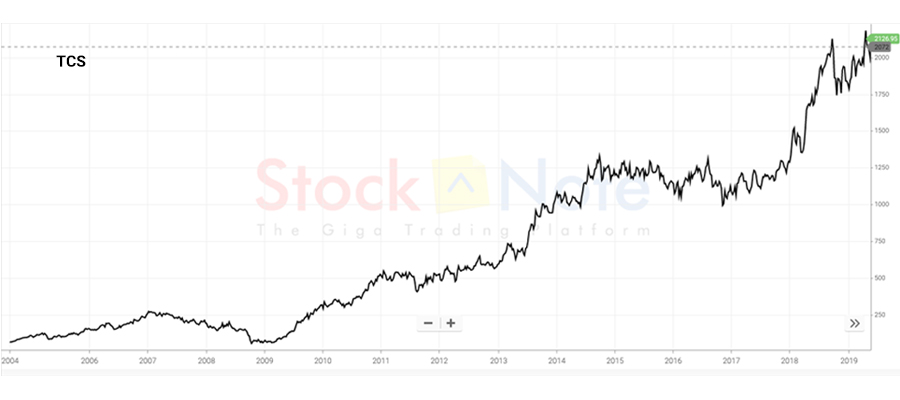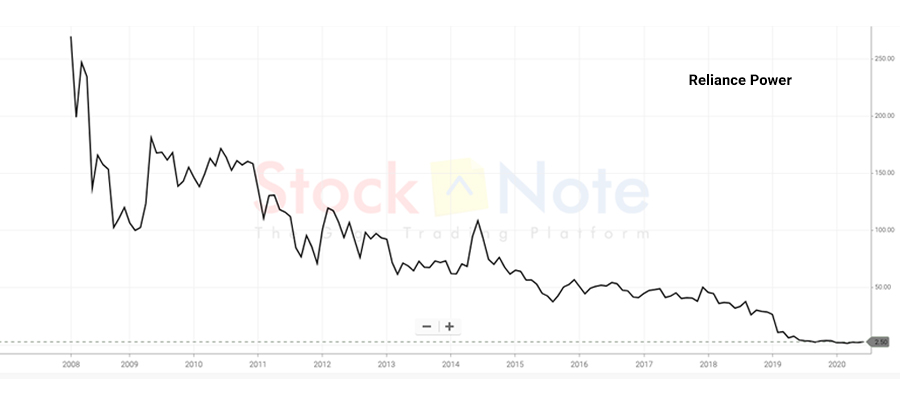Every Investor dreams of outperforming the market and creating wealth like the legendary Investor, Mr. Warren Buffett. But it takes an enormous amount of discipline, patience and perseverance to be a successful investor. Most of the long term value investors recommend the ‘Buy & Hold’ strategy to investment.
Buy and Hold is a long-term passive investment strategy where the investor is involved in selecting value stocks. Once the Investor identifies the right business, he locks it for the long term, thereby reducing taxes, increasing wealth and enjoying the benefit of compounding.
Most of the investors bet on the overall economy. Fortunately, India is a developing economy and therefore, has caught the attention of many investment funds across the globe. The long term story of most of the stocks in India has been beneficial to investors. Buy & Hold strategy has, therefore been a boon rather than a bane for most of the businesses.

Above is the stock price chart of TCS (since the date of listing). The stock has created wealth for its investors, and the value of investment today is more than 1600 times that of the original IPO price (adjusted for share-split and bonus).
In other words, if you had invested ₹1,00,000 in TCS in 2004, it would have become ₹14,40,000 (without considering the impact of dividend). TCS is the second largest company in terms of market capitalization listed on the Indian stock exchange.
Buy and Hold may seem to be a pretty simple strategy when you look at these 16 years at a stretch. Afterall one would have just held on to this stock all these years. But why is it that only a few were able to achieve much higher returns?
It surely isn’t the most straightforward strategy. For he who had done it, would have fought a hard battle and faced the following;
- The temptation to sell after seeing handsome profits.
- Refrain from shifting to more attractive stocks.
- Stock ticker tape, which made its presence felt every second.
- Not bragging like his fellow investors who made an instant profit.
- Sentiments of the market at the time of a bloodbath. e.g. the 2008 US Financial Crisis. etc. Avoiding panic selling.
This is correct. Identifying the right stock is just 50 per cent of the overall success. There are millions of traders sailing in the same boat, but their earnings tend to differ materially. Timing, price, time frame and temperament decides the returns from your investment as well. The long term growth depends on corporate earnings. However, the short term price fluctuations are based on sentiments. The earnings reported quarterly, but the price of the securities change every day.
Did you know?
Warren Buffett is one of the most successful investors of all time. His shareholding list is available to everyone. Yet only a few could make a fortune like him. There may be many reasons for this, but it can be narrowed down to only one – ‘Unrest’.
There’s a famous quote by Blaise Pascal which says- All of the human unhappiness comes from one single thing: not knowing how to remain at rest in a room. This is one of the great lessons for an investor who believes in the power of long term investing. He would not only buy and hold but will look for quality businesses that would sustain through the toughest of recessions. Long term investing is all about understanding the value of the business and not the price of the stock. One who understands the difference between the value perceived and the price of the stock – can become a successful investor.
However, if it was so easy to make money in the long run, why are most of the investors not following the same strategy? Also, if the long term story is optimistic, does stock picking even make a difference?
Well yes, business dynamics change from time to time, and so do the emotions. The behavior of other investors and the market conditions affect the investment portfolio. In changing business environment, it is of paramount importance to regularly review your existing portfolio and look for forward-looking opportunities.
And that’s why holding on to stocks – the ones that remain high quality – is elementary yet not as simple as it sounds. A profitable business today may or may not continue to stay profitable due to the business dynamism.
Although Buy and hold have provided immense wealth to many, who follow it. But it has undoubtedly been a wrong choice for some too. This is the chart of wealth destroyer Reliance Power since its IPO.

This is the chart of Reliance Power. If you had invested ₹100,000 in Reliance Power in 2008, you would be left with mere ₹1600.
Had the Investor reviewed the stock at regular intervals, he would have exited much before the crash and could have avoided erosion of capital beyond a point. In addition to periodic review, the Investor should also deploy risk management techniques to reduce the losses beyond a point.
How can one assure wealth creation in the long run?
As the business dynamics keep on changing, businesses may or may not remain profitable for the longest time. E.g. Automotive and fuel industry may become obsolete after the introduction of electric vehicles.
A long term investor should review a firm’s viability, scalability and sustainability before making a decision. He should be well equipped with the fundamental changes with the company, i.e. change in management, business model, geographies, product range etc. These are some of the ways through which an investor could make a fortune in the market.






